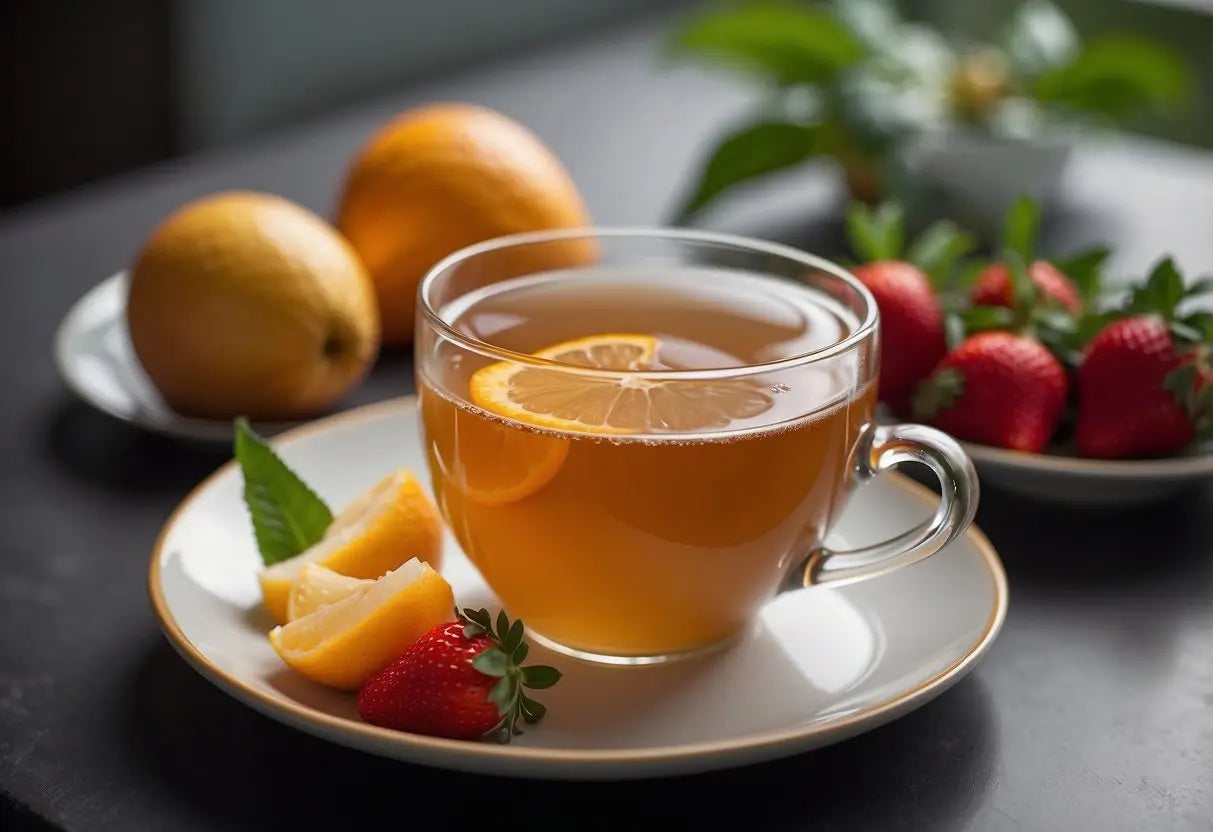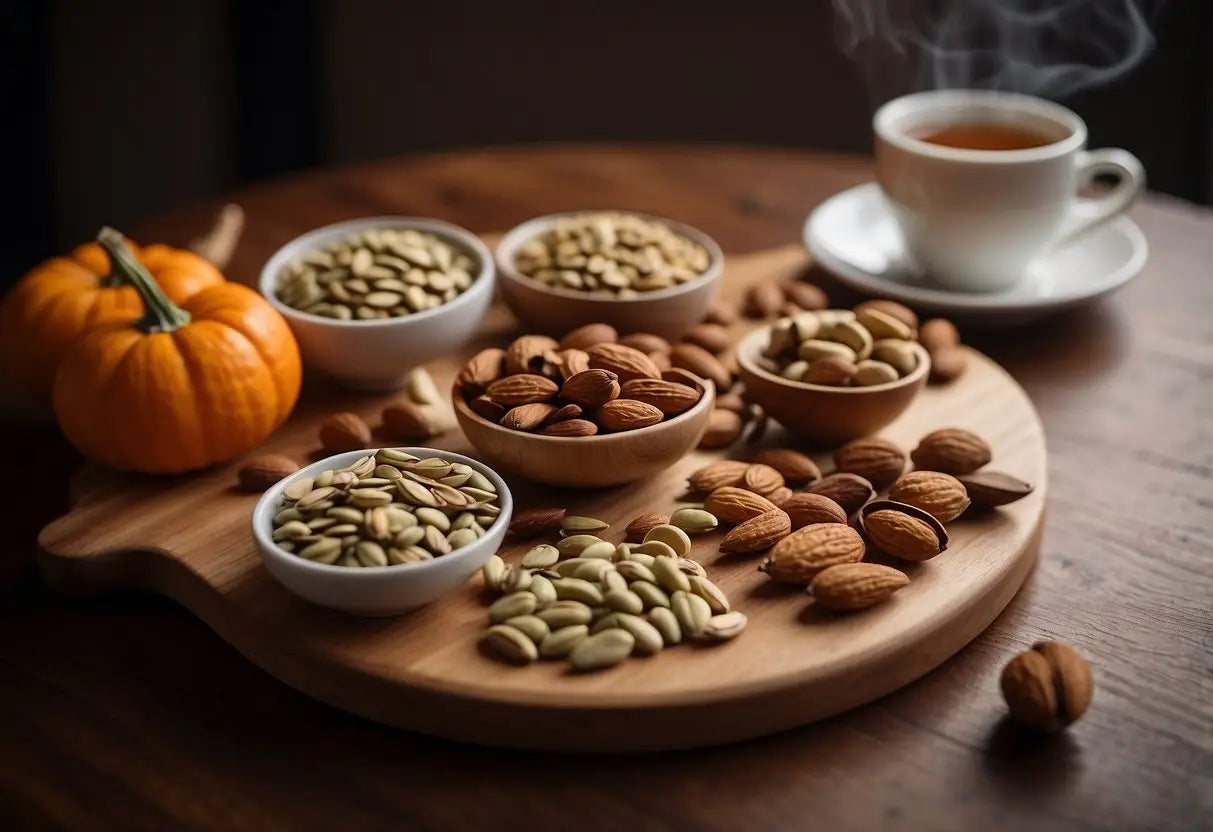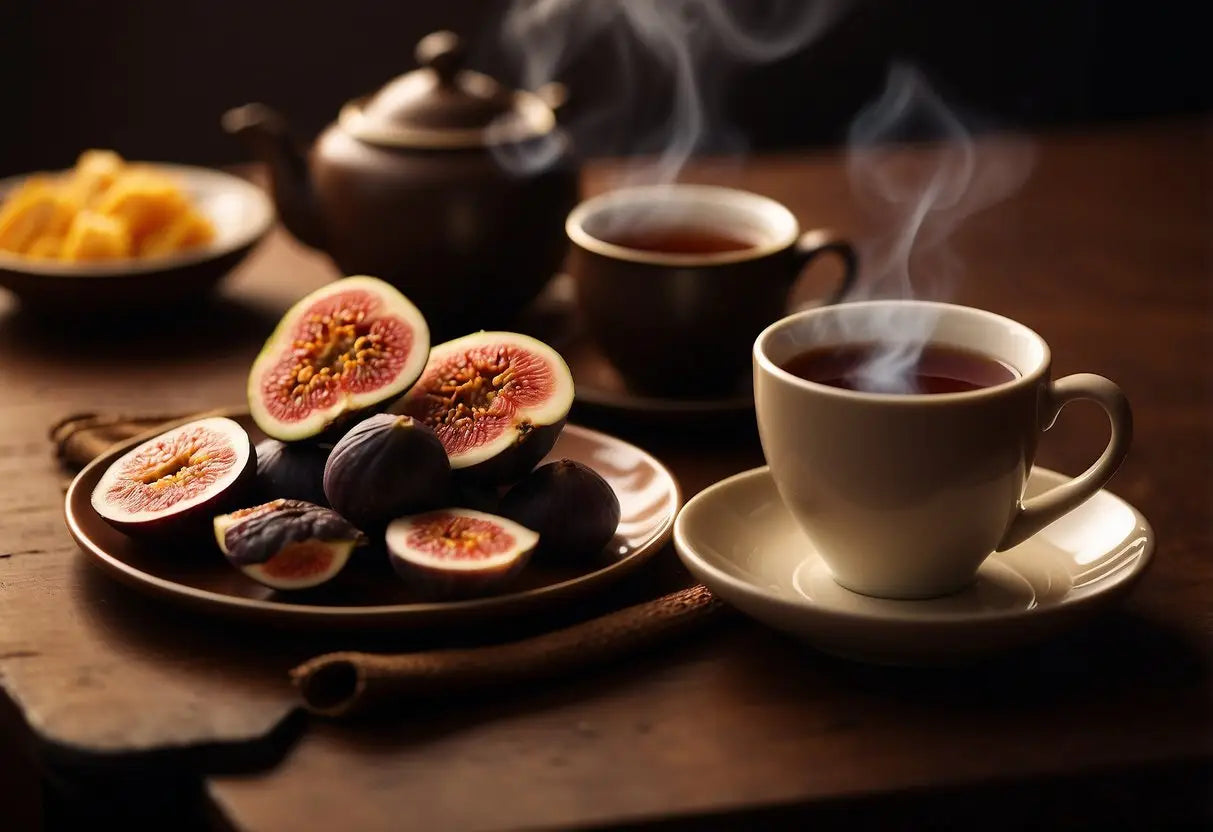What to Serve with Pu Erh Tea
Pairing Basics for Pu-erh Tea
Cheese: Pu-erh tea pairs wonderfully with cheese. Opt for aged cheeses like Gouda or Parmesan.
Nuts: The earthy flavors of this tea complement nuts. Try almonds, walnuts, or pecans.
Bestsellers
Fruits: Fresh fruits such as apples, pears, and citrus enhance the tea's complex profile.
Chocolate: Dark chocolate with a high cocoa content balances the tea's richness.
Meat: Smoky meats like duck or beef match well. You can also serve cured meats.
Sweets: Consider serving mooncakes, date cakes, or sesame balls for a traditional touch.
Spicy Dishes: Spicy foods like Sichuan cuisine harmonize with the tea's earthy base.
Here's a quick table for easy reference:
| Food Category | Recommended Items |
|---|---|
| Cheese | Gouda, Parmesan |
| Nuts | Almonds, Walnuts, Pecans |
| Fruits | Apples, Pears, Citrus |
| Chocolate | Dark Chocolate |
| Meat | Duck, Beef, Cured Meats |
| Sweets | Mooncakes, Date Cakes, Sesame Balls |
| Spicy Dishes | Sichuan Cuisine |
Experiment with these combinations to discover your favorite pairings for pu-erh tea.
Traditional Chinese Pairings

Dim Sum
Dim sum offers various dishes that go well with Pu-erh tea. Popular options include:
- Har Gow (shrimp dumplings)
- Siu Mai (pork dumplings)
- Char Siu Bao (barbecue pork buns)
The savory flavors of these dishes complement the rich notes of Pu-erh tea.
Noodles
Noodle dishes pair excellently with Pu-erh tea. Beef noodle soup and chicken chow mein are two favorites. The hearty broth and savory noodles balance the earthy taste of the tea.
Duck
Chinese roasted duck, especially Peking duck, is a classic pairing. The crispy skin and tender meat contrast the smooth and aged flavor of Pu-erh tea, creating a harmonious culinary experience.
Lao Ban Zhang
Pickled Vegetables
Serving pickled radish or pickled mustard greens can enhance your tea session. The tangy and salty flavors of the pickles provide a refreshing counterpoint to the tea’s earthiness.
Seafood
Seafood dishes like steamed fish with ginger and scallions or salt and pepper prawns are traditional choices. The light and fresh taste of seafood enhances the tea’s complex profile.
Mooncakes
During festive occasions, mooncakes paired with Pu-erh tea are a treat. The dense and sweet filling of mooncakes complements the tea's robust flavor, especially during the Mid-Autumn Festival.
Sweet Treats to Complement Pu-erh Tea

Pu-erh tea pairs well with a variety of sweet treats. These selections enhance the rich and earthy flavors of the tea.
Dark Chocolate
The bitterness of dark chocolate offsets the earthy tones of pu-erh tea. Aim for chocolate with at least 70% cocoa content.
Fruit Tarts
Fruit tarts add a refreshing, sweet flavor that complements pu-erh tea. Berries, citrus, and stone fruits work particularly well.
Honey Cakes
Honey cakes provide a natural sweetness that pairs beautifully with the complex flavors of pu-erh tea.
Almond Cookies
Almond cookies bring a nutty sweetness, offering a nice contrast to the tea’s deep flavors.
Suggested Pairings
| Sweet Treat | Notes |
|---|---|
| Dark Chocolate | Opt for 70% cocoa or higher |
| Fruit Tarts | Best with berries, citrus, and stone fruit |
| Honey Cakes | Natural sweetness, works nicely |
| Almond Cookies | Nutty and sweet, great combination |
Feel free to experiment with these options to find your favorite pairing.
Savory Snacks That Go Well With Pu-erh Tea

When pairing savory snacks with Pu-erh tea, consider selecting items that enhance the rich, earthy flavors of the tea.
Cheese pairs wonderfully with Pu-erh tea. Opt for aged cheeses such as Gouda or Cheddar. The robust flavors of these cheeses complement the tea's depth.
-
Nuts, especially almonds and cashews, provide a delightful crunch. Their natural oils and mild flavors balance well with the tea.
-
Olives are another excellent choice. Their briny taste contrasts nicely with Pu-erh's earthy notes.
Charcuterie like salami and prosciutto adds a savory touch. The saltiness of these cured meats enhances the tea’s flavor profile.
Savory crackers or breadsticks are also great options. They serve as a neutral base, allowing you to enjoy the complex flavors of the tea without distraction.
If you prefer something warm, consider spring rolls or dumplings. These snacks, often filled with vegetables or meat, are perfect matches for Pu-erh tea.
Remember to choose snacks that complement rather than overpower the tea.
Cheese Selections for Pu-erh Tea Pairing

When pairing cheese with pu-erh tea, consider hard and aged varieties. Their bold flavors complement the tea's rich, earthy notes.
Recommended Cheeses:
1. Aged Gouda
The sweet, nutty taste of aged gouda balances pu-erh tea's complexity.
2. Parmigiano Reggiano
Its sharp and savory profile enhances the tea's depth.
3. Gruyère
The creamy, slightly salty flavor pairs well without overpowering.
Blue Cheeses:
1. Roquefort
Roquefort's strong, tangy taste offers a unique contrast to pu-erh tea.
2. Stilton
Stilton's creamy texture and robust flavor mingle nicely with the tea.
Soft Cheeses:
1. Brie
Brie adds a mild, buttery counterpart to the tea's intense character.
2. Camembert
With its earthy undertones, Camembert mirrors some of pu-erh tea's notes.
Experiment with these selections to find your ideal pairing.
Pu-erh Tea and Chocolate

Pairing Pu-erh tea with chocolate can enhance your tasting experience. The earthy, robust flavor of Pu-erh complements various types of chocolate.
A dark chocolate with a high cocoa content (70% or more) pairs exceptionally well with aged Pu-erh. The bitterness of the chocolate balances the tea's smooth, aged flavor.
Milk chocolate, with its creamy and sweet profile, works well with younger Pu-erh tea. The lighter notes of the tea and the richness of the chocolate create a harmonious match.
Consider the following pairings:
| Type of Pu-erh Tea | Best Chocolate Pairing |
|---|---|
| Aged Pu-erh | Dark Chocolate (70% cocoa or more) |
| Young Pu-erh | Milk Chocolate |
| Fruity-flavored Pu-erh | Fruit-infused Chocolate (e.g., orange, raspberry) |
You might also explore flavored chocolates. For instance, chocolate infused with orange or mint can add an interesting dimension to your Pu-erh tea experience.
Remember, the key to a successful pairing is balance. The combined flavors should neither overpower each other nor be too muted. Enjoy experimenting to find your perfect match.
Fruit Pairings for Pu-erh Tea

Pu-erh tea pairs excellently with a variety of fruits. The right fruit can enhance the rich, earthy flavors of the tea.
Citrus Fruits:
- Oranges - Their sweet and tangy taste balances the depth of pu-erh tea.
- Lemons - A dash of lemon adds a refreshing zest.
- Grapefruits - Ideal for a bittersweet note.
Berries:
- Strawberries - Their sweetness complements the tea’s complexity.
- Blueberries - Adds a burst of flavor without overwhelming the tea.
- Raspberries - Tart and sweet, they provide a delightful contrast.
Tropical Fruits:
- Mango - Its juicy sweetness pairs well with the tea’s earthy tones.
- Pineapple - Brings a bright, acidic touch.
- Papaya - Offers a mellow and slightly sweet taste.
Stone Fruits:
- Peaches - Enhance the tea with a soft, fruity aroma.
- Plums - Their deep flavor matches the robust nature of pu-erh.
- Cherries - Sweet and slightly tart, perfect for adding complexity.
Melons:
- Cantaloupe - Adds a delicate, sweet flavor.
- Honeydew - Subtle and refreshing, ideal for a lighter taste.
Experiment with these pairings to find your perfect match. Each fruit brings out different nuances in the tea, making every sip a unique experience.
Nut and Seed Pairings

Pairing nuts and seeds with Pu Erh tea can enhance its earthy and robust flavors. Consider the following options:
Almonds
Almonds, with their sweet and slightly bitter notes, complement the deep, fermented qualities of Pu Erh tea.
Walnuts
Walnuts bring a rich, buttery taste that balances well with the tea’s complexity. Their slightly oily texture also contrasts nicely with the tea's astringency.
Pistachios
Pistachios offer a mild and unique flavor that doesn’t overpower the tea. The subtle sweetness of pistachios makes them an excellent companion.
Seeds
- Pumpkin Seeds: These seeds provide a nutty and slightly sweet flavor that pairs seamlessly with Pu Erh tea.
- Sunflower Seeds: Sunflower seeds add a mild, savory taste, and their slight saltiness can enhance the tea's depth.
- Sesame Seeds: The nuttiness of sesame seeds complements the earthy notes of Pu Erh, and their small size makes them easy to snack on during tea sessions.
Mixes
Creating a mix of nuts and seeds can add a variety of textures and flavors, making your tea experience more enjoyable. Try combining almonds, walnuts, and pumpkin seeds for a balanced snack.
Herbal Infusions and Aromatics

Pairing herbal infusions with Pu Erh tea can enhance its natural flavors. Aromatics like mint or lemon balm introduce refreshing notes that complement the earthy undertones of the tea.
Chamomile offers a calming effect, balancing Pu Erh's robust taste, while ginger adds a spicy kick, creating a delightful contrast.
You can experiment with lavender for a floral note or rosemary for a pine-like freshness. Both herbs offer unique experiences that enhance your tea session.
Consider creating a simple chart to explore combinations:
| Herb | Flavor Profile |
|---|---|
| Mint | Refreshing, cool |
| Lemon Balm | Light, citrusy |
| Chamomile | Calming, floral |
| Ginger | Spicy, warm |
| Lavender | Floral, aromatic |
| Rosemary | Pine-like, fresh |
Mix and match these infusions with Pu Erh tea to discover your preferred flavor profiles. Always adjust quantities to your taste, starting with small amounts to avoid overpowering the tea.
If you're serving guests, presenting a variety of herbal infusions alongside Pu Erh tea allows them to customize their experience. Keep dried herbs in small jars or containers, clearly labeled, for an organized and inviting setup.
Enjoy the balance and refinement that each herb brings to your tea, inviting exploration and enjoyment.
Dietary Considerations for Pairings

When pairing foods with Pu Erh tea, keep in mind the dietary preferences of your guests.
Vegetarian Options:
- Fresh Fruits: Apples, pears, and oranges.
- Nuts: Almonds, cashews, and walnuts.
- Cheese: Soft cheeses like brie and camembert.
Vegan Choices:
- Vegetable Sushi: Avocado, cucumber, and seaweed.
- Nut-based Snacks: Trail mix with dried fruits.
- Hummus: Paired with vegetable sticks.
Gluten-Free Ideas:
- Rice Crackers: A light, crunchy option.
- Quinoa Salad: Mixed with herbs and lemon juice.
- Corn Tortilla Chips: Great with a mild salsa.
Low-Calorie Pairings:
- Green Salad: With a light vinaigrette.
- Steamed Vegetables: Like broccoli and carrots.
- Air-popped Popcorn: A low-calorie, crunchy snack.
Consider keeping a variety of options to suit different dietary needs. This ensures everyone can enjoy their Pu Erh tea experience fully.
Seasonal Pairing Ideas

Spring
Spring brings fresh flavors. Pair Pu erh tea with light salads, especially those featuring citrus fruits or fresh greens. Steamed vegetables and fresh berries also complement the earthy notes of the tea.
Ideal combinations:
- Arugula salad with orange slices
- Steamed asparagus
- Fresh strawberries
Summer
Summer calls for refreshing and light foods. Cold dishes, such as gazpacho or sushi, go wonderfully with Pu erh tea. Fresh fruits like watermelon and mango can add a sweet contrast.
Ideal combinations:
- Sushi rolls
- Gazpacho
- Slices of watermelon or mango
Fall
During fall, hearty and warm flavors become the focal point. Serve Pu erh tea with roasted vegetables, pumpkin dishes, or apple desserts. These foods enhance the rich, earthy taste of the tea.
Ideal combinations:
- Roasted butternut squash
- Pumpkin soup
- Apple pie
Winter
Winter pairs well with robust, warming dishes. Think about hearty stews, spiced meats, or rich desserts like dark chocolate. The bold flavors stand up well to Pu erh tea.
Ideal combinations:
- Beef stew
- Lamb with rosemary
- Dark chocolate squares
← Older post Newer post →











